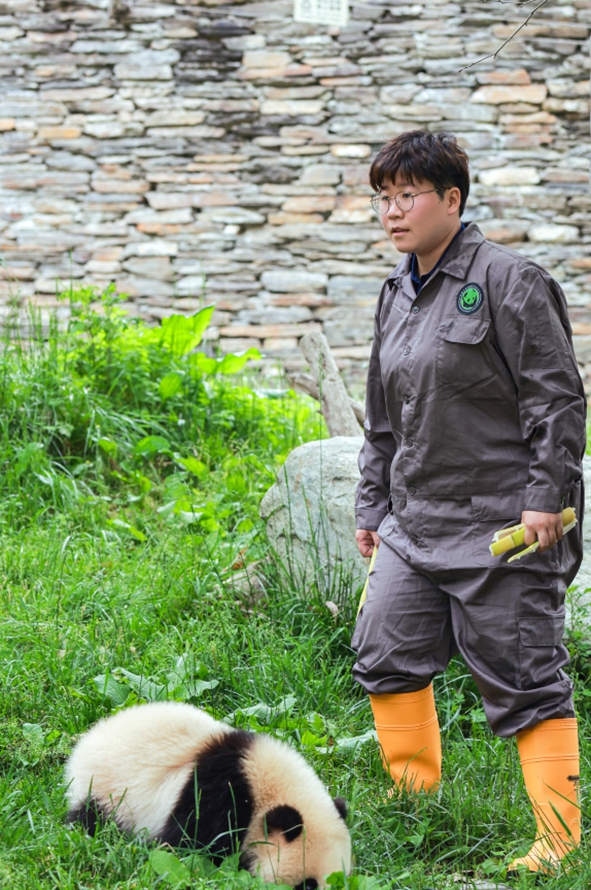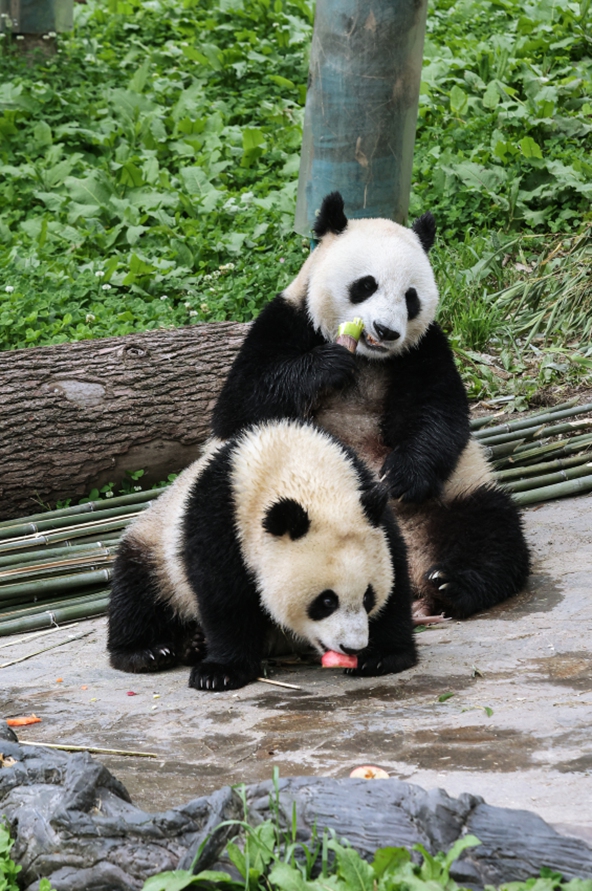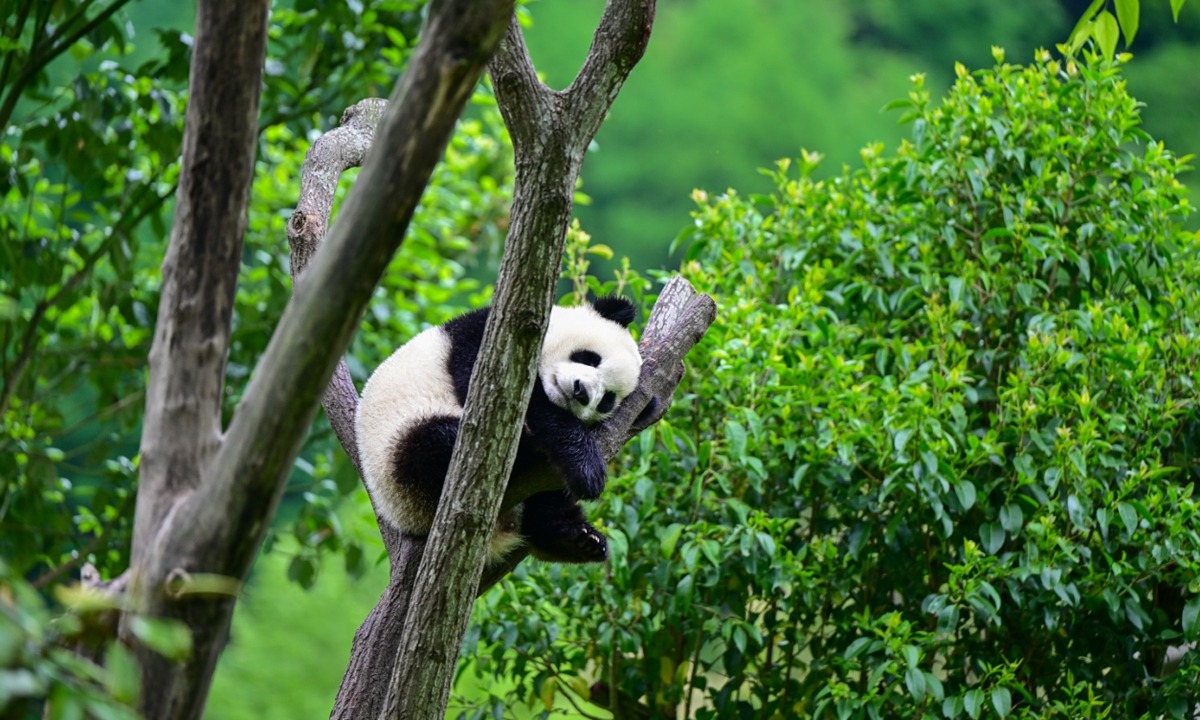
Ma Xiaoyu stands beside a giant panda. Photo: Courtesy of the China Conservation and Research Centre for the Giant Panda
Gao Gao the giant panda is 32 years old, equivalent to 112 years old in human age. Although he is in the sunset years of his life with some unavoidable age-related health issues such as abraded teeth, Gao Gao still lives in the Dujiangyan panda park of the China Conservation and Research Centre for the Giant Panda (CCRCGP) and has been nicknamed "Grandpa Gao."
Chen Rui, one of the breeders at the CCRCGP who is in charge of taking care of Gao Gao, told the Global Times that he still remembers when he first met the giant panda at the airport after returning to China from the US.
"The lovely 'grandpa' was a fussy eater at the time," Chen recalled, adding that it took a lot of efforts to transform Gao Gao's "addiction" to cookies, persuading him to accept a more balanced diet.
Such stories of giant pandas like "Grandpa Gao" and their breeders happening every day at the breeding base have been presented in a TV show called Panda's Family, recently released on Hunan TV and Mango TV, capturing how Chinese breeders guard giant pandas from cradle to grave and help them return to the wild, giving the public a new perspective on the interactions between humans and animals.
Netizens commented that they saw the cross-species affection between breeders such as Chen and Li Rong and the pandas in their care. These breeders, who are the closest humans to giant pandas, dedicate most of their time and energy to the work and become family to the giant pandas.
The team of panda breeders is growing larger. In the TV show, six younger interns gain experience as breeders and also build firm bonds with the pandas they are caring for. Ma Xiaoyu, one of the interns, told the Global Times that she is eager to take the mantle of caring for giant pandas after officially joining the team.
The program has since come to an end, but the story of the harmonious relationship between humans and giant pandas, as it extends into the natural world, lives on.

Giant panda Xin Xin and its cub Photo: Courtesy of the China Conservation and Research Centre for the Giant Panda
Love and trustMornings at the breeding base are typically busy for Ma. She and other interns need to clean the colony houses for more than one hour and then prepare the giant pandas' breakfast on time, a basin of milk formula specifically formulated for panda cubs and fresh bamboo for the adult pandas.
They then monitor and record the situation of pandas every half hour to spot and rapidly respond to any abnormalities in the pandas' behavior. The collected data is then given to veterinarians and biological experts regularly to help safeguard the endangered animals' health.
"The feeding capability of panda cubs is not like that of the adults, so we need to care for the cubs skillfully and patiently," Li told the Global Times. She has been responsible for taking care of panda moms and their cubs.
The delicate nature of panda cubs also challenges Li's ability to observe and react. She said that they must take painstaking measures to prevent the cubs from contracting diseases as mild as influenza. "Accurately telling if panda cubs are ill usually relies on plenty of experience," Li noted.
Now Li has developed the "eye," instantly taking note of tiny dangerous factors as minute as a wooden thorn in a panda cub's toy.
Chen, who works in panda-related healthcare for aged pandas, has also expressed concern over the fragile state of giant pandas' health. He said that illness among old pandas is usually cumulative and he has to closely monitor surrounding pandas' excrement and movement to confirm if they are healthy.
Chen and Li both mentioned that their attitude to the work has transformed from just a responsibility to an indispensable part of life after becoming closely involved with pandas. Additionally, the pandas also display deep affection and trust in the breeders.

Photo: Courtesy of the China Conservation and Research Centre for the Giant Panda
Destination in nature
"Tao Tao, as you walk into nature today, I wonder if we will have the chance to meet again in this lifetime. I hope you grow healthier and stronger in the wild and build your own family," Mou Shijie, the CCRCGP's breeder responsible for captive pandas' rewilding training and release, said to himself when staring at the first panda he trained and released running in the woods.
Chinese giant panda breeders not only care for captive pandas, but also try hard to help the endangered species return to the wild and maintain a wild population. Mou is a veteran member of the rewilding team.
Mou said that rewilding training work consists of two stages. The first is to build trust with panda moms and ensure that the nutritional needs of the cubs are met. When the cubs are about 1 year old, the mom and cubs are transferred to a broader area ready for training.
"The panda mother leads her cubs in the training area, where they can freely eat bamboo, find water sources, locate shelter, and learn crucial survival skills like avoiding predators. These are lessons only a panda mother can teach; we humans can't instill that wild instinct in them," Mou noted.
So far, the CCRCGP has successfully trained and released nine giant pandas back into the wild, which should ultimately be their true home.






